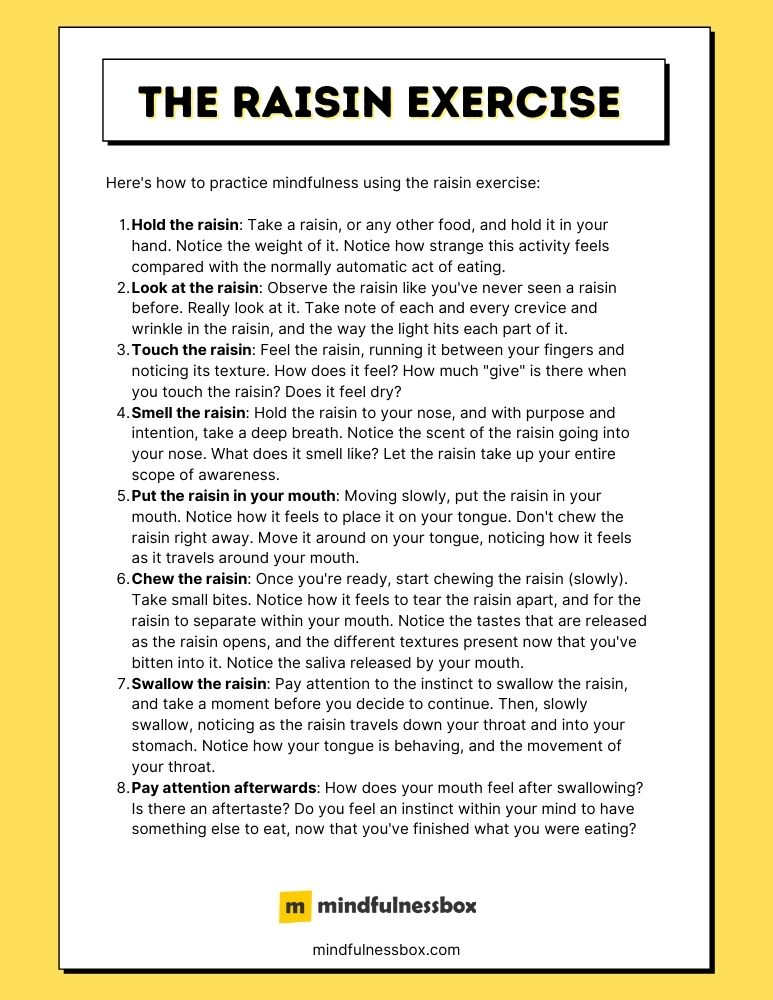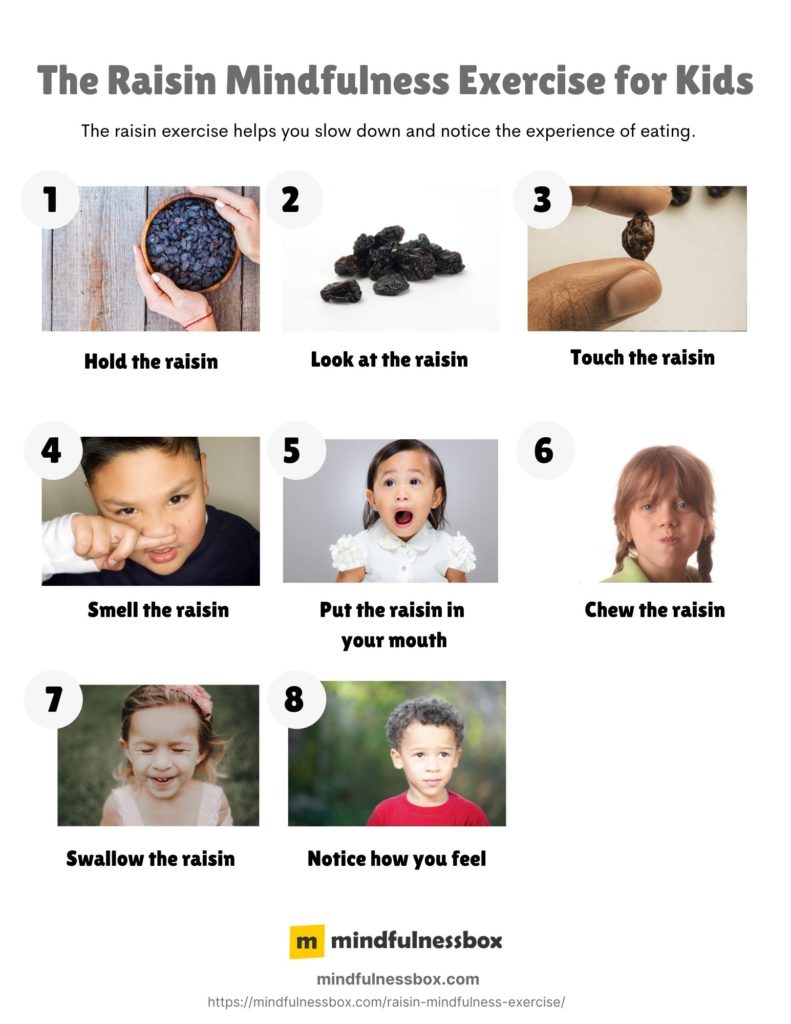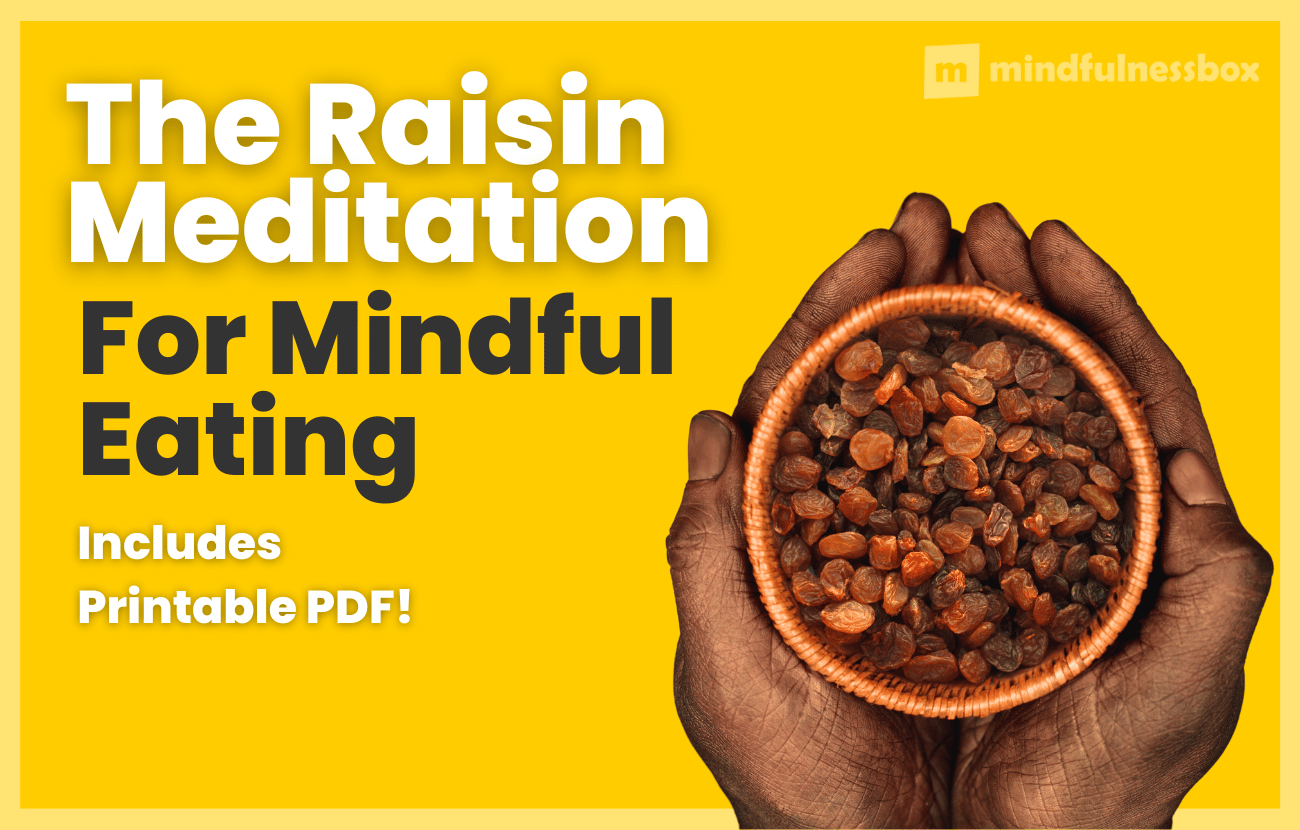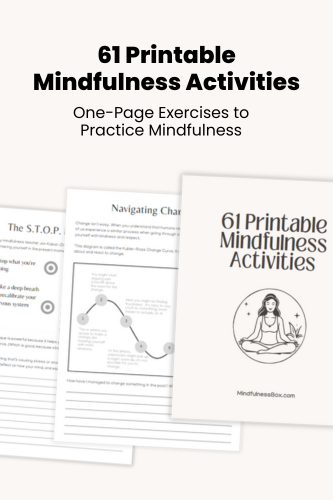The raisin exercise for mindfulness, also known as the raisin meditation, is a mindful eating exercise that helps us practice staying present, even during activities that we normally do on autopilot. To do the exercise, you take a raisin and slowly observe it with all of your senses: touch, taste, smell, sight, and sound. Then, you pay attention to how you feel at the end of the exercise.
For most of us, it’s not easy to stop and smell the proverbial roses.
It’s easy to get caught up in life and forget to pay attention to what we’re actually doing.
Get dozens of one-page exercises to help practice mindfulness, meditation, gratitude, and self love. Perfect for printable handouts when teaching mindfulness to groups, students, or in the workplace.
To see examples, plus a full list of the 61 exercises included, click below.
The mindfulness raisin exercise was developed as a simple way to help people slow down and pay attention to the present moment. It has a long history, having first been integrated into mindfulness programs in 1979 as a part of the research-backed Mindfulness-Based Stress Reduction program.
Let’s dive into the raisin exercise, and how eating raisins might actually help you live more mindfully.
What is the mindfulness raisin exercise?

The raisin mindfulness exercise is a mindful eating practice involving a single raisin, along with the application of all of your senses.
Mindfulness teacher Jon Kabat-Zinn is credited with creating the raisin mindfulness meditation.
Kabat-Zinn is considered to be one of the pioneers of mindfulness in the West. His Mindfulness-Based Stress Reduction Program (MBSR), an eight-week training program first developed in 1979, includes the raisin meditation.
To do the exercise, all you need is a raisin. Place the raisin in the bowl or plate and take a few minutes to look at it closely. Notice the color, shape, and size of the raisin. Then, pick up the raisin and hold it in your hand. Notice how the raisin feels against your skin. Smell the raisin and notice how it smells. Finally, eat the raisin and notice how it tastes.
When you’re finished, take a few minutes to reflect on your experience.
As simple as it sounds, the mindful raisin exercise challenges you to focus on the present moment and appreciate the small things in life.
A printable raisin mindfulness script

If you want to try the raisin mindfulness exercise, here are the steps:
- Hold the raisin: Take a raisin, or any other food, and hold it in your hand. Notice the weight of it. Notice how strange this activity feels compared with the normally automatic act of eating.
- Look at the raisin: Observe the raisin like you’ve never seen a raisin before. Really look at it. Take note of each and every crevice and wrinkle in the raisin, and the way the light hits each part of it.
- Touch the raisin: Feel the raisin, running it between your fingers and noticing its texture. How does it feel? How much “give” is there when you touch the raisin? Does it feel dry?
- Smell the raisin: Hold the raisin to your nose, and with purpose and intention, take a deep breath. Notice the scent of the raisin going into your nose. What does it smell like? Let the raisin take up your entire scope of awareness.
- Put the raisin in your mouth: Moving slowly, put the raisin in your mouth. Notice how it feels to place it on your tongue. Don’t chew the raisin right away. Move it around on your tongue, noticing how it feels as it travels around your mouth.
- Chew the raisin: Once you’re ready, start chewing the raisin (slowly). Take small bites. Notice how it feels to tear the raisin apart, and for the raisin to separate within your mouth. Notice the tastes that are released as the raisin opens, and the different textures present now that you’ve bitten into it. Notice the saliva released by your mouth.
- Swallow the raisin: Pay attention to the instinct to swallow the raisin, and take a moment before you decide to continue. Then, slowly swallow, noticing as the raisin travels down your throat and into your stomach. Notice how your tongue is behaving, and the movement of your throat.
- Pay attention afterwards: How does your mouth feel after swallowing? Is there an aftertaste? Do you feel an instinct within your mind to have something else to eat, now that you’ve finished what you were eating? Can you notice any changes in sensation in your mouth, throat, or stomach?
Benefits of the raisin meditation
How often have you stopped to observe all of the directions your mind is going in while you eat?
This is one of the benefits of the raisin meditation. Instead of letting your mind run in a million directions, you’re able to focus your mind on the actual experience of eating. It’s surprising how little we do this, without intention.
In this way, the raisin exercise can also help you to practice being more present, even in the middle of activities during which you’re normally on autopilot. It’s a proven way to improve your focus on the present moment, while practicing gratitude for the small things in life.
It’s also helpful from a mindful eating and weight loss perspective, giving you a chance to intentionally work on your relationship with food. Going from eating on autopilot and quickly, to eating intentionally and slowly, can make a big difference in your experience of eating and your decisions around food.
The mindfulness raisin exercise for kids

The mindful raisin exercise is a fun and effective way to introduce mindfulness meditation to children.
Sitting still and observing your thoughts can be a difficult practice for young kids. But this exercise is an entertaining, interactive practice that’s concrete and easy to understand.
Kids may be more motivated to meditate if they’re given the chance to explore something with their full awareness.
At first, you can teach mindfulness meditation by having kids place a raisin in their mouth and then slowly chewing it (with no swallowing), while paying attention to how it tastes. As they have more time to get used to the exercise, you can have them pause before putting the raisin in their mouth, so they can take time to notice how the raisin feels, smells, and even how it sounds as they interact with it.
What if I don’t like raisins?
No problem!
You can do this raisin activity with any food.
Raisins are the subject of this mindfulness eating exercise because they were the food originally used in the Mindfulness-Based Stress Reduction curriculum. However, they don’t have any special impact on mindfulness. Most likely, the creators of the curriculum simply wanted to use a food that was easily preserved, had an interesting texture, didn’t need to be refrigerated, and didn’t commonly cause allergies.
For this reason, raisins are still a good choice if you’re creating a mindfulness eating script for your classroom or mindfulness training program.
Using the raisin meditation in daily life
The raisin exercise for mindfulness is simply one of many attention practices intended to help you stay in the present moment during daily life.
However, it’s unique in that it uses all of the senses, and is accessible for anyone, even kids and those who are new to mindfulness.
It’s also especially helpful for those who want to focus on mindful eating. The act of mindfully eating a raisin can build habits that carry over to your regular meals, helping you pay more attention to the act of eating, and changing your relationship with food.
The raisin exercise doesn’t need to be a regular mindfulness practice for you. But give it a try, if only to observe how it feels to slow down and engage all your senses during the normally routine act of eating.
Frequently asked questions
What can a raisin teach you about mindfulness?
The raisin mindfulness exercise is a way to focus your mind on the present moment while eating. It can help you to be more present during activities and improve your focus. Additionally, it can help you to have a better relationship with food. Simply find a raisin (or any other food) and slow down, engaging all of your senses as you go through the process of observing the raisin, smelling it, tasting it and eating it.
Raisin exercise PDFs
Here’s a printable Mindfulness Raisin Exercise PDF showing how to do the raisin mindfulness exercise. You can share with a classroom or mindfulness training group.
Print out this raisin meditation script, bring some raisins, and you’re good to go!

My mindfulness practice kicked off in 2016 with a ten-day silent retreat. Since then, I’ve read dozens of books about mindfulness and completed hundreds of hours of meditation. Thinking about what makes humans happy, calm, and peaceful is endlessly fascinating to me.


